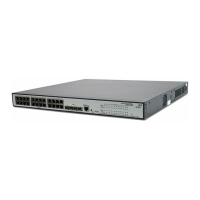322 CHAPTER 30: CLUSTER
■ The management device sends NTDP topology collection requests periodically
through its NTDP-enabled ports.
■ Upon receiving an NTDP topology collection request, the device returns a NTDP
topology collection response to the management device and forwards the
request to its neighbor devices through its NTDP-enable ports. The topology
collection response packet contains the information about the local device and
the NDP information about all the neighbor devices.
■ The neighbor devices perform the same operation until the NTDP topology
collection request is propagated to all the devices within the specified hops.
When an NTDP topology collection request is propagated in the network, it is
received and forwarded by large numbers of network devices, which may cause
network congestion and the management device busy processing of the NTDP
topology collection responses. To avoid such cases, the following methods can be
used to control the NTDP topology collection request advertisement speed.
■ Configuring the devices not to forward the NTDP topology collection request
immediately after they receive an NTDP topology collection request. That is,
configure the devices to wait for a period before they forward the NTDP
topology collection request.
■ Configuring each NTDP-enabled port on a device to forward an NTDP topology
collection request after a specific period since the previous port on the device
forwards the NTDP topology collection request.
n
■ To implement NTDP, you need to enable NTDP both globally and on specific
ports on the management device, and configure NTDP parameters.
■ On member/candidate devices, you only need to enable NTDP globally and on
specific ports.
■ Member and candidate devices adopt the NTDP settings of the management
device.
Introduction to Cluster
A cluster must have one and only one management device. Note the following
when creating a cluster:
■ You need to designate a management device for the cluster. The management
device of a cluster is the portal of the cluster. That is, any operations from
outside the network intended for the member devices of the cluster, such as
accessing, configuring, managing, and monitoring, can only be implemented
through the management device.
■ The management device of the cluster recognizes and controls all the member
devices in the cluster, no matter where they are located in the network and
how they are connected.
■ The management device collects topology information about all
member/candidate devices to provide useful information for you to establish
the cluster.
■ By collecting NDP/NTDP information, the management device learns network
topology, so as to manage and monitor network devices.
■ Before performing any cluster-related configuration task, you need to enable
the cluster function first.

